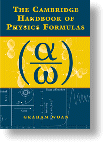Clarifications, and corrections
are posted here
2003 edition
- Periodic table (page 124): the units of the lattice constant are pm, not fm. Many thanks go to Javier Hasbun for spotting this long-standing typo.
- Cherenkov cone angle (page156): By the usual definition of a Cherenkov cone angle (angle between shock rays rather than wavefronts), the left hand side of equation 7.246 should be the cosine of the cone semi-angle, not the sine. I'm very grateful to Alan Watson for gently pointing this out!
Corrections
to earlier editions:
General
Chapter 1
- The new CODATA Recommended Values of the Physical
Constants are now available. The small changes to these values are
largely academic for users who work to only a few decimal places, but see
http://physics.nist.gov/cuu/Constants/index.html
if you need those extra digits (or, in the case of big G, fewer digits!)
Chapter 2
- Typo on page 23, Equation 2.47. There is a 'theta'
missing in the middle. The expression should read:

Well spotted by Yuki Takahashi.
- p.57: the domain for the Poisson distribution (2.550)
is 'x = 0,1,2,...' not 'x=1,2,3,...'
Chapter 4
- Page 91 equation 4.19: the hbar and i on the
right hand side should both be raised to the power n. Thanks to Shawn
Kwang for spotting that one.
Chapter 8
- The right-hand side of equation 8.115 is actually
equal to the mean collision time rather than the half width at half power,
so should be the reciprocal of what is printed. Pressure broadening increases
(rather than decreases) with pressure! So the entry should read:

Chapter 9
- Page 177 top panel needs some clarification - I hope
you are concentrating...
Equation 9.6 returns the GMST at the start (0h UT) of the calendar date
in question, D/M/Y, using T as the fractional number of Julian centuries
between 12h UT on 1 Jan 2000 and this instant. However, the T
defined in 9.5 uses integer Julian days (as defined in 9.1) and is therefore
incompatable with the half day implicit in the GMST calculation. For
9.6 to return the GMST at 0h on D/M/Y you should use the integer JD derived
from 9.1 and a value of T=(JD-2451544.5)/36525 (which is 9.5 with a
half-day correction). The GMST at other times of the day can be
calculated quite accurately as an offset from this instant, using the
definition of the sidereal second (page 14). In addition, be careful
with 9.1. It really is designed for fortran/C integer arithmetic, and
may give incorrect answers if implimented in other languages. Here
is an improved version of the panel.
Changes made to
the 2000 print run
- Back cover: 'Professor
Anthony Hewish' should read 'Professor Antony Hewish'.
- Only the hardback edition contains a handy
summary of physical constants on the inside of the back cover. However,
a pdf file for this is available here, so you
can stick it in your paperback and upgrade it!
- Page 14: The entry for 'reyn' should of
course come after 'REN' in an alphabetical list, and there are one or
two other ordering errors like this, none of them serious. The next edition
will contain a table of letters in alphabetical order, for my own use ...
- Page 71. The footnote should add
that when using these equations for the two-body problem (is when M
is similar to m) occurrences of M should be replaced by (M+m),
in addition to m being replaced by the reduced mass.





